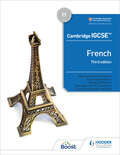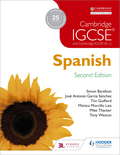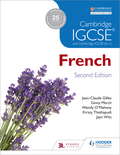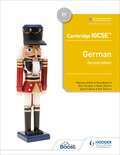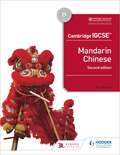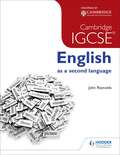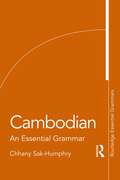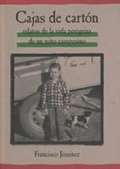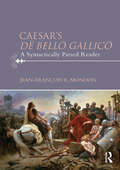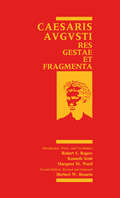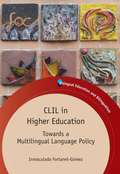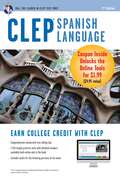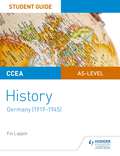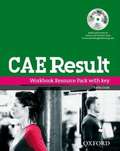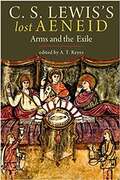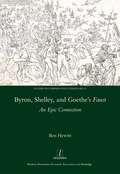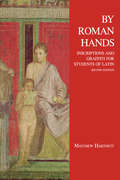- Table View
- List View
Cambridge IGCSE™ French Student Book Third Edition
by Paul Shannon Jean-Claude Gilles Jayn Witt Kirsty Thathapudi Wendy O'Mahony Séverine Chevrier-Clarke Virginia MarchThis title is endorsed by Cambridge Assessment International Education to support the full syllabus for examination from 2021.Strengthen language skills and cultural awareness with a differentiated approach that offers comprehensive coverage of the revised Cambridge IGCSE™ French (0520/7156) syllabuses for first examination from 2021.- Develop the cultural awareness at the heart of the syllabus with engaging stimulus material and questions from around the world which will encourage a positive attitude towards other cultures- Progress the ability to use the language effectively with activities developing all four key skills, supported by teacher notes and answers in the teacher guide- Stretch and challenge students to achieve their best, whilst supporting all abilities with differentiated content throughout- Ensure the progression required for further study at A-level or equivalent- Help to prepare for the examination with exam-style questions throughoutAudio is available via the Boost eBook, Boost subscription or the Teacher Guide.Also available in the seriesReading and Listening Skills Workbook ISBN: 9781398329416Grammar Workbook ISBN: 9781510447547 Vocabulary Workbook ISBN: 9781510448049Study and Revision Guide ISBN: 9781510448032 Boost eBook ISBN: 9781398329645Boost digital teacher resources ISBN: 9781398329607Teacher Guide with audio ISBN: 9781510447776Teaching and Learning Resources ISBN: 9781510447783
Cambridge IGCSE® Spanish Student Book Second Edition
by Tony Weston José García Sánchez Mónica Morcillo LaizThis Student Book provides a grammar-led approach with extensive exam preparation to develop independent, culturally aware students of German, ready for the exam.This book is endorsed by Cambridge International Examinations for the latest IGCSE® (0525) and International Level 1/Level 2 Certificate (0677) syllabuses. Extensive use of German reflects the style of the exams and, with specific advice and practice, it helps students use the acquired skills to their best ability. Topics on German-speaking cultures are integrated throughout to ensure students gain the cultural awareness that is at the heart of this qualification.- Develop students' ability to use German effectively - Stretch and challenge students to achieve their best grades - Ensure the progression required for further study at A-level or equivalent - Provide insight and encourage a positive attitude towards other culturesThe book provides up-to-date content following a clear sequencing of topics designed specifically for teaching German at this level. It is designed to develop spontaneous, confident linguists who are able to progress to further study of German.- Teacher Resource + Audio-CDs (ISBN 9781471833076) includes all recordings and transcripts together with detailed guidance, editable vocabulary lists, cultural PowerPoints and interactive quizzes- Grammar Workbook (ISBN 9781471833182)Vocabulary is also available online at Vocab Express, an interactive learning applicationVisit www.vocabexpress.co.uk/hodder for more information.
Cambridge IGCSE® French Student Book Second Edition
by Jean-Claude Gilles Wendy O'Mahony Virginia MarchThis Student Book provides a grammar-led approach with extensive exam preparation to develop independent, culturally aware students of German, ready for the exam.This book is endorsed by Cambridge International Examinations for the latest IGCSE® (0525) and International Level 1/Level 2 Certificate (0677) syllabuses. Extensive use of German reflects the style of the exams and, with specific advice and practice, it helps students use the acquired skills to their best ability. Topics on German-speaking cultures are integrated throughout to ensure students gain the cultural awareness that is at the heart of this qualification.- Develop students' ability to use German effectively - Stretch and challenge students to achieve their best grades - Ensure the progression required for further study at A-level or equivalent - Provide insight and encourage a positive attitude towards other culturesThe book provides up-to-date content following a clear sequencing of topics designed specifically for teaching German at this level. It is designed to develop spontaneous, confident linguists who are able to progress to further study of German.- Teacher Resource + Audio-CDs (ISBN 9781471833076) includes all recordings and transcripts together with detailed guidance, editable vocabulary lists, cultural PowerPoints and interactive quizzes- Grammar Workbook (ISBN 9781471833182)Vocabulary is also available online at Vocab Express, an interactive learning applicationVisit www.vocabexpress.co.uk/hodder for more information.
Cambridge IGCSE German Student Book Second Edition
by Amy Bates Mariela Affum Alice GruberThis title is endorsed by Cambridge Assessment International Education to support the full syllabus for examination from 2021.Strengthen language skills and cultural awareness with a differentiated approach that offers comprehensive coverage of the revised Cambridge IGCSE? German (0525/7159) syllabuses for first examination from 2021.- Develop the cultural awareness at the heart of the syllabus with engaging stimulus material and questions from around the world which will encourage a positive attitude towards other cultures- Progress the ability to use the language effectively with activities developing all four key skills, supported by teacher notes and answers in the teacher guide- Stretch and challenge students to achieve their best, whilst supporting all abilities with differentiated content throughout- Ensure the progression required for further study at A-level or equivalent- Help to prepare for the examination with exam-style questions throughoutAlso available in the seriesGrammar Workbook ISBN: 9781510448056 Vocabulary Workbook ISBN: 9781510448063 Study and Revision Guide ISBN: 9781510448186 Student eTextbook ISBN: 9781510448728 Whiteboard eTextbook ISBN: 9781510448424 Online Teacher Guide ISBN: 9781510448544 Teaching and Learning Resources ISBN: 9781510448377
Cambridge IGCSE Mandarin Chinese Student's Book 2nd edition
by Yan BurchThis title is endorsed by Cambridge Assessment International Education to support the full syllabus for examination from 2022.Provide guidance, exercises and examples in all four key skills, with speaking, listening, reading and writing integrated into every chapter; updated to support the revised Cambridge IGCSETM Mandarin Chinese (0547) syllabus.- Improve comprehension and delivery of language with all four key skills comprehensively covered throughout with icons to identify when each skill should be used and practised.- Enhance speaking skills with Pinyin (phonetics) that aid correct pronunciation.- Aid understanding with vocabulary and grammar boxes that offer clear explanations and examplesentences.- Build skills with exercises arranged progressively from simple, to complex and comprehensive.- Provide additional practice with the accompanying Workbook, perfect as a course companion or homework book for use throughout the course.- Engage, challenge and motivate you student with interactive resources from our partner Languagenut*, for more information visit www.hoddereducation.co.uk/languagenut*The Languagenut resources are not part of the Cambridge International endorsement process.Also available in the series:Student eTextbook 9781510485129 Whiteboard eTextbook 9781510485112 Workbook 9781510485402
Cambridge IGCSE English as a second language
by John ReynoldsEndorsed by Cambridge International ExaminationsAn easy and cost-effective way to teach both the speaking and listening components.This title has been written for the latest Cambridge IGCSE English as a Second Language (0510 and 0511) syllabuses.- Prepares students for their exams with a focus on assessed language features, such as inference, opinion and attitude- Develops language abilities at an appropriate pace.
Cambridge Handbooks in Language and Linguistics: The Cambridge Handbook of Bilingual Processing
by John W. SchwieterHow does a human acquire, comprehend, produce and control multiple languages with just the power of one mind? What are the cognitive consequences of being a bilingual? These are just a few of the intriguing questions at the core of studying bilingualism from psycholinguistic and neurocognitive perspectives. Bringing together some of the world's leading experts in bilingualism, cognitive psychology and language acquisition, The Cambridge Handbook of Bilingual Processing explores these questions by presenting a clear overview of current theories and findings in bilingual processing. This comprehensive handbook is organized around overarching thematic areas including theories and methodologies, acquisition and development, comprehension and representation, production, control, and the cognitive consequences of bilingualism. The handbook serves as an informative overview for researchers interested in cognitive bilingualism and the logic of theoretical and experimental approaches to language science. It also functions as an instrumental source of readings for anyone interested in bilingual processing.
Cambridge Classical Studies: Oscan in Southern Italy and Sicily
by Katherine McdonaldIn pre-Roman Italy and Sicily, dozens of languages and writing systems competed and interacted, and bilingualism was the norm. Using frameworks from epigraphy, archaeology and the sociolinguistics of language contact, this book explores the relationship between Greek and Oscan, two of the most widely spoken languages in the south of the peninsula. Dr McDonald undertakes a new analysis of the entire corpus of South Oscan texts written in Lucania, Bruttium and Messana, including dedications, curse tablets, laws, funerary texts and graffiti. She demonstrates that genre and domain are critical to understanding where and when Greek was used within Oscan-speaking communities, and how ancient bilinguals exploited the social meaning of their languages in their writing. This book also offers a cutting-edge example of how to build the fullest possible picture of bilingualism in fragmentary languages across the ancient world.
Cambridge Bioethics and Law: Criminalising Contagion
by Hannah Quirk Catherine StantonThe use of the criminal law to punish those who transmit disease is a topical and controversial issue. To date, the law (and the related academic literature) has largely focused on HIV transmission. With contributions from leading practitioners and international scholars from a variety of disciplines, this volume explores the broader question of if and when it is appropriate to criminalise the transmission of contagion. The scope and application of the laws in jurisdictions such as Canada, the United Kingdom and Norway are considered, historical comparisons are examined, and options for the further development of the law are proposed.
Cambodian: An Essential Grammar (Routledge Essential Grammars)
by Chhany Sak-HumphryCambodian: An Essential Grammar is an accessible guide to the grammatical themes, patterns, and structures of the Cambodian language.Across 14 chapters, the book introduces both basic and more complex examples in the written and spoken language. With its use of plain language and avoidance of complicated linguistic jargon, this is an accessible and user-friendly grammar. Examples are presented in Cambodian, English, and Romanized transliteration scripts, and draw on up-to-date data from the colloquial speech of Cambodian people in a wide variety of contexts.This is a key reference for all students, professionals, researchers, and general readers wishing to advance their Cambodian grammar from beginner level and is designed for both independent and class-based studies.
Call If You Need Me (Mandarin Edition)
by Raymond CarverCall If You Need Me includes all of the prose previously collected in No Heroics, Please, four essays from Fires, and those five marvelous stories that range over the period of Carver's mature writing and give his devoted readers a final glimpse of the great writer at work. 本书为卡佛小说 散文 随笔和书评的合集 所选文章以类相从 全景敞视般地展示出卡佛风格的多样性 从而使读者得以窥见其一生文学创作的丰富维度 此书还特别收录五篇新近发现的卡佛生前未结集的短篇作品 阅读卡佛 读者可见其对现代社会中底层人边缘性的关注 其实也是自身经历的一种言说 时至今日仍可引起绝大多数人共鸣 此合集沿袭了卡佛一贯的风格 文风冷峻 看似削到嶙峋的文字之中其实蕴含无尽深意
California Tesoros de lectura: Lectura/Artes del lenguaje [Grade 1, Volume 3]
by Jana Echevarria David J. Francis Elva DuránNIMAC-sourced textbook
Cakes and Ale (Mandarin Edition)
by W MaughamCakes and Ale is a delicious satire of London literary society between the Wars. Social climber Alroy Kear is flattered when he is selected by Edward Driffield's wife to pen the official biography of her lionized novelist husband, and determined to write a bestseller. But then Kear discovers the great novelist's voluptuous muse (and unlikely first wife), Rosie. 在 寻欢作乐 里 毛姆从现实中取材 将虚实相掺 借故事叙述者阿申登之口讲述了其与著名作家德里菲尔德及其前妻罗西的早年交往 而这段往事正是另一位流行小说家基尔所要挖掘的传记素材 读者可依稀指认出德里菲尔德是在影射哈代 基尔由休·沃尔波尔脱胎而来 至于罗西 则分明是乔伊斯笔下莫莉·布鲁姆的翻版
Cajas de cartón (English and Espanol)
by Francisco JiménezCajas de cartón contains twelve stories of a Mexican-American migrant family, told from the viewpoint of one of the children, Panchito. Authentically told, the stories detail hard times like poverty, hunger, and backbreaking work. Still, there is always the message of hope and perseverance. Cajas de cartón incluye doce cuentos sobre una familia migrante y mexicana-estadounidense. Panchito, uno de los niños, cuéntanoslos. Las historias son muy auténticas y describen tiempos de pobreza, hambre, y trabajo difícil, pero todavía hay una mensaje de esperanza y perseverancia.
Caesar’s Dē Bellō Gallicō: A Syntactically Parsed Reader
by Jean-François R. Mondon<p>Caesar’s Dē Bellō Gallicō: A Syntactically Parsed Reader is an innovative Latin reader presenting selections of Caesar’s Gallic wars texts. Its unique approach tackles the two most common problems a student reading unedited Latin faces: abundant vocabulary and a maze-like sentence structure. Breaking down the sentence structure of the texts and providing vocabulary glosses throughout, A Syntactically Parsed Reader ensures better comprehension and enables students to make an easier transition from using artificial and doctored Latin to working with the unaltered language found in authentic texts. <p>Features include: <p> <li>Texts presented with the syntactically parsed Latin on one page and vocabulary glosses on the other <li>Visual display of the syntactic structure of each Latin sentence throughout, with main clauses touching the left margin, subordinate clauses shown indented, and multiple subordinate clauses arranged to illustrate which clauses are dependent on which other clauses <li>Helpful grammar notes provided alongside the texts <li>High frequency vocabulary included in a separate appendix to encourage efficient vocabulary acquisition <li>Selected texts carefully chosen in line with the Advanced Placement Latin exam. </li> <p> <p>Caesar’s Dē Bellō Gallicō: A Syntactically Parsed Reader has been developed by an experienced university instructor. It is ideal for students seeking to improve their ability to read and understand Latin prose straight from the page.</p>
Caesaris Augusti: Res Gestae et Fragmenta
by Herbert BenarioThe Res Gestae and Fragmenta by Caesar Augustus annotated for beginning Latin students.
Caesar: Selections From His Commentarii De Bello Gallico
by Julius Caesar Hans-Friedrich Mueller Donald E. Sprague Bridget S. DeanNIMAC-sourced textbook
CLIL in Higher Education
by Inmaculada Fortanet-GomezThis book offers a unique view of multilingualism in higher education from a global perspective. It presents a contextualised case of a multilingual language policy which takes the Content and Language Integrated Learning (CLIL) approach. The volume discusses various approaches to multilingual education including CLIL and then proposes guidelines for a multilingual language policy for Universitat Jaume I in Castelló, Spain. It examines the advantages of a multilingual education programme and reviews the success of existing language policies. This book will be an essential resource for researchers and students as well as policy makers.
CLEP® Spanish Language: Levels 1 and 2 (CLEP Test Preparation)
by Viviana Gyori April Schneider Ms. Lisa J. GoldmanSave time and money while you earn college credit. Pass your CLEP exam and get college credit at a fraction of the cost of a college course with REA's Prep for CLEP.Our exclusive Book + Online prep includes:Focused drills: Master the material as you go, with over 250 drill questions. Test-aligned subject review: Zero in on the topics you'll find on the exam. Two realistic practice exams (with audio): Measure your test-readiness so you'll be confident and prepared on test day. Expert advice from authors who know the test inside out. Glossary of key terms: Round out your prep with must-know Spanish vocabulary and idioms. REA is America's recognized leader in CLEP test prep and is your trusted source for the most up-to-date, aligned content. If you're looking to accelerate your path to a college degree, CLEP is perfect for you. And thanks to our partners at Proctortrack (proctortrack.com/clep), now you can take your exam at your convenience, from the comfort of home.
CCEA AS-level History Student Guide: Germany (1919-1945)
by Fin LappinBuild, reinforce and assess students' knowledge throughout their course; tailored to the 2016 CCEA specification and brought to you by the leading History publisher, this study and revision guide combines clear content coverage with practice questions and sample answers. - Ensure understanding of the period with concise coverage of all Unit content, broken down into manageable chunks- Develop the analytical and evaluative skills that students need to succeed in A-level History- Consolidate understanding with exam tips and knowledge-check questions- Practise exam-style questions matched to the CCEA assessment requirements for every question type, including source-based examples- Improve students' exam technique and show them how to reach the next grade with sample student answers and commentary for each exam-style question- Use flexibly in class or at home, for knowledge acquisition during the course or focused revision and exam preparation
CCEA AS-level History Student Guide: Germany (1919-1945)
by Fin LappinBuild, reinforce and assess students' knowledge throughout their course; tailored to the 2016 CCEA specification and brought to you by the leading History publisher, this study and revision guide combines clear content coverage with practice questions and sample answers. - Ensure understanding of the period with concise coverage of all Unit content, broken down into manageable chunks- Develop the analytical and evaluative skills that students need to succeed in A-level History- Consolidate understanding with exam tips and knowledge-check questions- Practise exam-style questions matched to the CCEA assessment requirements for every question type, including source-based examples- Improve students' exam technique and show them how to reach the next grade with sample student answers and commentary for each exam-style question- Use flexibly in class or at home, for knowledge acquisition during the course or focused revision and exam preparation
CAE Results: Workbook Resource Pack with Key
by Kathy Gude Lynda EdwardsThe new multi-level exam preparation series for Cambridge ESOL exams which inspires students to better exam results.
C. S. Lewis's Lost Aeneid: Arms and the Exile
by C. S. Lewis A. T. ReyesC. S. Lewis (1898–1963) is best remembered as a literary critic, essayist, theologian, and novelist, and his famed tales The Chronicles of Narnia and The Screwtape Letters have been read by millions. Now, A. T. Reyes reveals a different side of this diverse man of letters: translator. <p><p> Reyes introduces the surviving fragments of Lewis's translation of Virgil's epic poem, which were rescued from a bonfire. They are presented in parallel with the Latin text, and are accompanied by synopses of missing sections, and an informative glossary, making them accessible to the general reader. Writes Lewis in A Preface to Paradise Lost, “Virgil uses something more subtle than mere length of time…. It is this which gives the reader of the Aeneid the sense of having lived through so much. No man who has read it with full perception remains an adolescent.” Lewis's admiration for the Aeneid, written in the 1st century BC and unfolding the adventures of Aeneas, a Trojan who traveled to Italy and became the ancestor of the Romans, is evident in his remarkably lyrical translation. <p><p> C. S. Lewis's Lost Aeneid is part detective story, as Reyes recounts the dramatic rescue of the fragments and his efforts to collect and organize them, and part illuminating look at a lesser-known and intriguing aspect of Lewis's work.
Byron, Shelley and Goethe's Faust: An Epic Connection
by Ben HewittThe first part of Goethe's dramatic poem Faust (1808), one of the great works of German literature, grabbed the attention of Byron and Percy Shelley in the 1810s, engaging them in a shared fascination that was to exert an important influence over their writings. In this comparative study, Ben Hewitt explores the links between Faust and Byron's and Shelley's works, connecting Goethe and the two English Romantic poets in terms of their differing, intricately related experiments with epic. In so doing, Hewitt enters the three writers into a literary and philosophical dialogue concerning 'epic' and 'tragic' perspectives on human knowledge and potential - perspectives crucial to the very structure and significance of Goethe's masterpiece - and illuminates hitherto unacknowledged affinities between these key figures in Romantic literature, and between British and German Romanticisms.
By Roman Hands: Inscriptions and Graffiti for Students of Latin
by Matthew HartnettBy Roman Hands takes Latin out of the textbook and allows students to see and translate Latin as it actually appeared on Roman monuments, walls and tombs. The first collection of entirely authentic and un-adapted inscriptions and graffiti accessible to beginning and intermediate students of Latin, By Roman Hands unites the study of language and culture in a novel and compelling way and at a level that the Latin can be grasped and discussed by early Latin learners. Ranging from a love letter hastily scratched on a Pompeian wall to the proclamation of an emperor's achievements formally inscribed on a monumental arch, these carefully selected texts afford fascinating glimpses into the lives and minds of the Romans, even as they illustrate and reinforce the basic elements of the Latin language. This edition, revised to work in parallel with the second edition of Susan Shelmerdine' s Introduction to Latin or any standard beginning Latin text, includes more texts and illustrations, and an additional section of inscriptions for practice and review.
